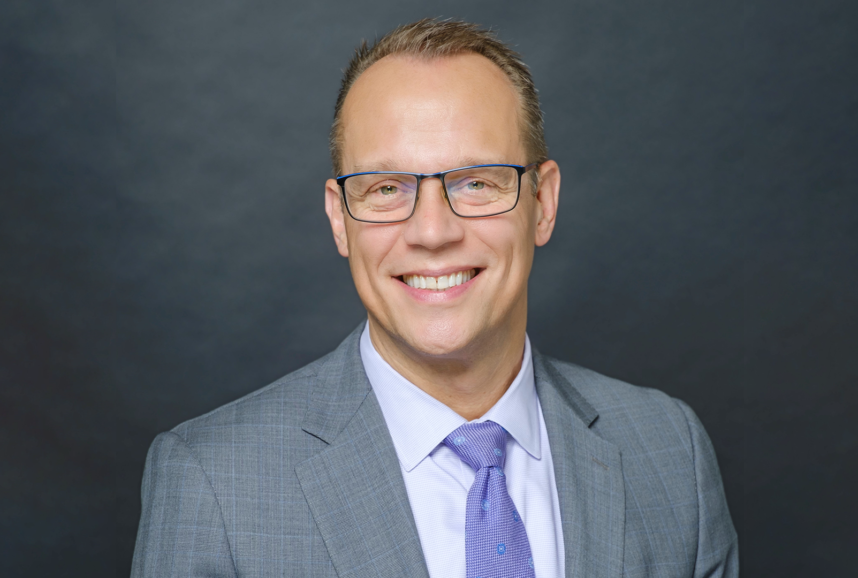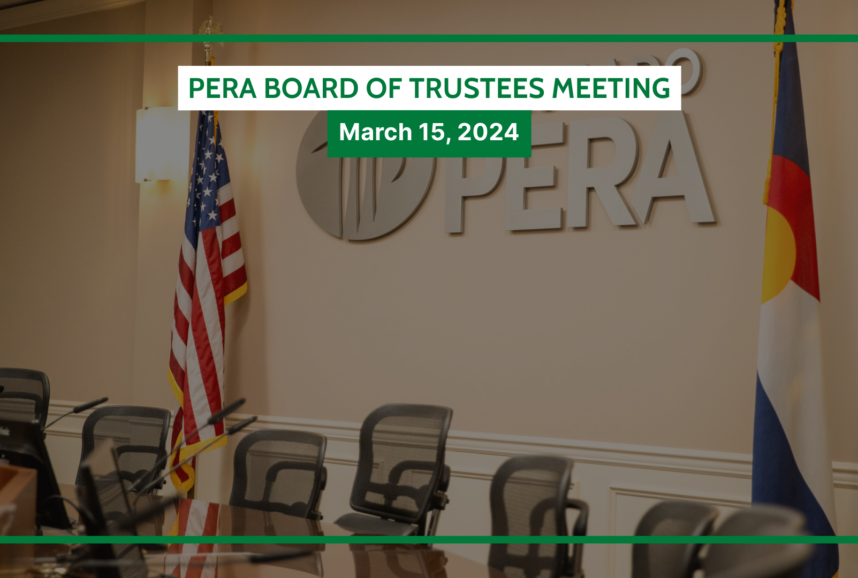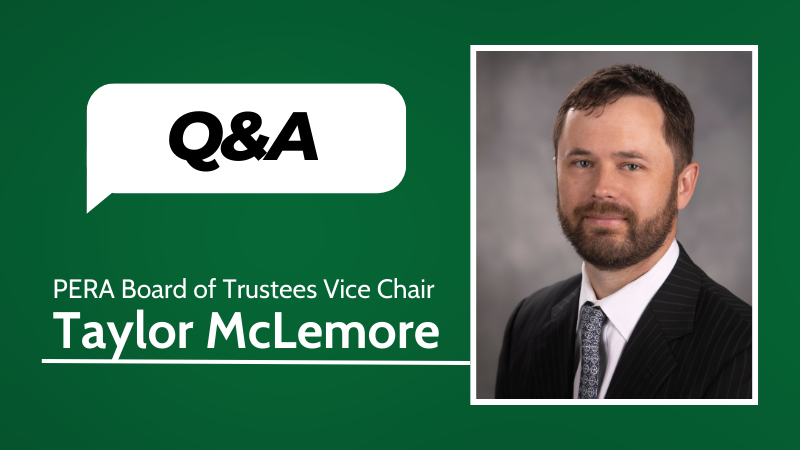On Tuesday, June 26, Colorado PERA conducted telephone town halls for members and retirees. If you missed the calls, recordings and transcripts of each call have been posted here.
A summary of the most asked questions and responses is below. Questions about individual retirement benefits may be answered by contacting PERA Customer Service at 1-800-759-7372.
Q: How does the automatic adjustment feature in Senate Bill 200 work?
A: The provision requires automatic changes to four components of PERA funding: member contributions, employer contributions, the State’s direct distribution, and the annual increase (AI) paid to retirees. Prior to SB 200, the only way that contribution rates or annual increase percentages could change was by passing legislation.
With the automatic adjustment feature of SB 200, if PERA’s projected period to reach full funding falls behind the funding goal, contributions and the direct distribution would increase (the direct distribution will not exceed $225 million) while the AI would decrease (but not lower than 0.5 percent). If the funding period moves ahead of the goal, contributions and the direct distribution would decrease, and the AI would increase. There are limitations on increases or decreases in a single year.
See the Automatic Adjustment fact sheet for details.
Q: Why are the different divisions within PERA treated differently? For example, employers in the Local Government Division won’t be contributing more and won’t receive any of the direct distribution from the State.
A: The reason behind a different contribution level for Local Government employers is the division has a better funded status and the additional contributions were not needed to bring the division to full funding within 30 years. Keep in mind that employers in the Local Government Division do not receive funding from the State currently and therefore are not included in the divisions receiving a portion of the direct distribution.
Q: What was the impact of SB 200 on PERA’s funded status?
A: Each division is a separate trust (School, State, Denver Public Schools, Judicial, Local Government). The projected amortization period (or the time it will take to be fully funded) for each division, recognizing the changes in SB 200 and incorporating the 2017 investment return, is below.
Amortization Period for Each Division
| Division | Projected Period of Time to Reach Full Funding |
| State | 27 years |
| School | 30 years |
| Local Government | 15 years |
| Judicial | 15 years |
| Denver Public Schools (DPS) | 17 years |
Q: How does the direct distribution work?
A: In short, the direct distribution of $225 million will come directly to PERA from the state budget each year. This amount may decrease, if the automatic adjustment provision kicks in, but will never exceed $225 million. For more information, please see this PERA on the Issues post and fact sheet.
Q: I recently read an article about PERA’s investment expenses. Can you explain what PERA spends on investment fees?
A: The article was focused on private equity and real estate investment fees. The goal of these asset classes is outperformance and diversification versus the public markets over the long term, which they have provided. For the 10-year period ending December 2017, PERA’s investments have outperformed a hypothetical 60 percent global equity, 40 percent fixed income portfolio by approximately $3.1 billion dollars. In other words, PERA’s investment program that includes private equity has generated $3.1 billion more than if PERA didn’t invest in the asset class. .
Q: What is PERA’s position on divesting from certain investment opportunities, such as fossil fuels?
PERA invests on behalf of the membership to achieve one goal: to secure the retirement benefits promised to Colorado’s current and former public employees. The PERA Board has a fiduciary obligation to the membership and, in part, fulfills its obligation by designing an investment strategy that seeks to maximize returns. That said, the Board routinely reviews its existing policies related to investment prohibitions. In June 2018, the Board’s Investment Committee began reviewing and possibly updating the Statement on Divestment adopted by the Board in 2007. The Investment Committee members received educational presentations from their fiduciary counsel, their investment consultant, and PERA staff regarding Divestment and engagement. The Board will continue its process of deliberation on this topic over the next few months.
Q: What is PERA doing about the Windfall Elimination Provision in Social Security?
A: Because the Windfall Elimination Provision (WEP) saves the Social Security trust fund money (and getting rid of it would cost the federal government money), Congress has been reluctant to act. PERA and the national organizations in which we participate track movement on federal legislation and if there is any news on this front, we will certainly share it with PERA members.
Read more on the WEP here.
Q: Will PERA employees and the Board be sacrificing like the rest of us?
PERA employees and Trustees elected by the membership are PERA members and will be affected by the changes of SB 200. See the Impact of Changes fact sheet for more information.
Still have a question? Submit it to AskPERA@copera.org.
Global equityA type of investment that includes publicly traded stocks in companies based in the United States and abroad.Asset classesA category of similar investments. Common asset classes include global equity (such as publicly traded stocks), real estate, and cash.Windfall elimination provisionA provision of federal law that may reduce Social Security benefit payments to retirees who receive a pension based on work during which they did not contribute to Social Security. The WEP does not apply to those with 30 or more years of substantial earnings in Social Security.Trust fundA fund in which money and/or other assets are held and managed by trustees on behalf of plan participants. PERA maintains trust funds for each of its Defined Benefit Plan divisions (State, Local Government, School, Denver Public Schools, and Judicial).FiduciaryA person who manages money on someone else’s behalf and who has a sworn responsibility to manage those funds in the best interest of the client. DivestmentThe act of selling one’s investments in a particular company or sector, often for philosophical or political reasons.DivestmentThe act of selling one’s investments in a particular company or sector, often for philosophical or political reasons.DivestmentThe act of selling one’s investments in a particular company or sector, often for philosophical or political reasons.AmortizationThe act of paying down debt or liabilities over time.AmortizationThe act of paying down debt or liabilities over time.Private equityA type of investment in which investors purchase shares of a company that is not traded on a public stock exchange.Fixed incomeA type of investment that pays investors a fixed rate of interest over a set period of time. Bonds are a common type of fixed income investment.Asset classA category of similar investments. Common asset classes include global equity (such as publicly traded stocks), real estate, and cash.Asset classA category of similar investments. Common asset classes include global equity (such as publicly traded stocks), real estate, and cash.





All I know is that my retirement benefit won’t go up for another 2 years and when it does, it will be at a reduced percentage. Hoo-ray!, Bet the cost of insurance will increase though, right?
I was wondering how the salaries paid to the Officers of PERA affect the benefits available to PERA members. I’ve heard, but do not know, that the salaries of the Executive Director and high-level Officers are relatively high. Can you comment?
Dear Mr. Dobrovolny,
Thank you for your question. PERA has 300 employees who invest contributions and administer retirement and other benefit programs on behalf of 580,000 members. PERA employee salaries are competitive with the marketplace and in line with the Board’s Total Compensation Philosophy which you will find here: https://www.copera.org/sites/default/files/documents/totalcomp.pdf
An external consultant has found that it costs PERA $52 per member/retiree to administer the system. This is lower than our peers across the country, and the service delivered is above our peers. You can read more about that here: https://www.peraontheissues.com/index.php/2017/10/04/how-does-pera-measure-up/
Administrative expenses are outlined on page 124 of the Comprehensive Annual Financial Report: https://www.copera.org/sites/default/files/documents/5-20-17.pdf
What about a reply regarding my comment/question that I left as a voice message after the Telephone Town Hall?
Dear Mr. Lilly,
We are working through the voice messages left after the Telephone Town Hall and finishing up the last few. Thank you for your patience.
Thanks for this update. PERA is the major portion of my retirement income and I appreciate this legislation and PERA’s development of it to keep the fund healthy.
I want to know why you keep talking about 100% funded. In 1997 or 1998 or about that time Pera was funded at 105% or 110%. Will we just could not be funded at 100% and programs were put in place to encourage people to purchase more years and add years to their retirement and retire earlier. I was working for CDOT and we had 40, 50 ,60 people retiring every month for about a year. So if we become 100% funded again, is the same thing going to happen? PERA cannot be 100% funded. I say yes it can!
Dear Ms. Herrick,
The PERA Board of Trustees has adopted a funding policy that outlines the goals of the system. You may read the funding policy here: https://www.copera.org/sites/default/files/documents/fundingpolicy2015.pdf
I retired from teaching six years ago. I love my PERA Ponzi scheme. I made my investment back 3 years ago. What a life when the government can run a scheme no one else can, and I get to be a part of it!
Dear Mr. Adamson,
Just to be clear, PERA has assets that total $49 billion. Contributions from members and their employers are invested to prefund future benefit payments.
Did PERA employees get a raise this year? If so, why would they get a raise and the retirees not get one?
Dear Mr. Hamilton,
PERA employees are compensated based on performance and external workforce surveys so that the best employees are attracted and retained to serve the 580,000 current and retired members of PERA. PERA employees are also PERA members and will be impacted by the provisions of SB 200 (by contributing more while working and waiting three years before becoming eligible for an annual increase once retiring).
Among all the groups impacted by the rescinding of benefits ,(loss and severe future reduction of AI) there is
only ONE group affected that didn’t have any ability to opt out and leave the system. That is the retirees.
Any other currently working person could make their decision to stay with PERA or leave.
The burden of continuing to pay in to the system after retirement is unheard of and disgraceful. Since the 2010 taking, and now the the 2018 taking, PERA has taken back close to $44,000 in deferred income from my family. This I consider to be a direct contribution to PERA, paid involuntarily from income earned and contracted-for prior to my retirement decision. PERA can and should introduce legislation to exclude current retirees from retro-active taking of benefits. The retiree share of the “burden” was paid up front. I know of no pension system that requires fully vested employees to continue to pay-in after retiring. Now is the time. Return retirees to the benefits in place at the time of their retirement.
FULL FUNDING OF PERA IS NOT NECESSARY. I CAN UNDERSTANDING WANTING FUNDING OF PERA AT 75 TO 80% BUT THIS DRASTIC CHANGE IS OVERKILL. PERA RETIREES WENT SEVERAL YEARS WITH ABSOLUTELY NO INCREASES TO COVER THE COST OF LIVING. WHAT WE HAVE RECEIVED SINCE IS NEXT TO NOTHING. IT DOES NOT COVER THE ANNUAL INCREASES IN MEDICARE, DR. COPAYS OR PERSCRIPTIONS. WHEN WE RETIRED IN THE LATE 90’S WE FELT CONFIDENT IN HAVING PERA TO LIVE ON. NOW THAT THE COLORADO LEGISLATURE IN INVOLVED, I.E. SUBJECT TO POLITICAL WHIMS, WE CAN NO LONGER BE CONFIDENT IN WHAT WILL HAPPEN NEXT.